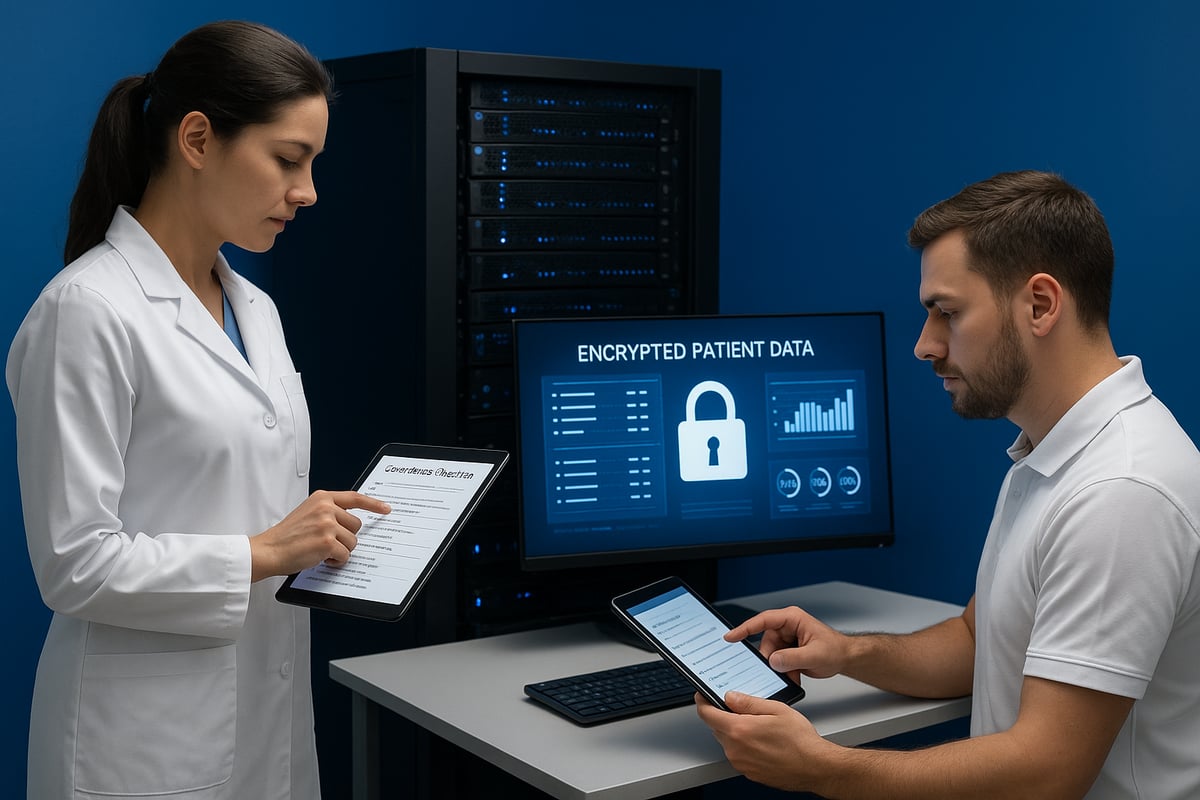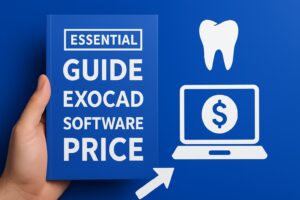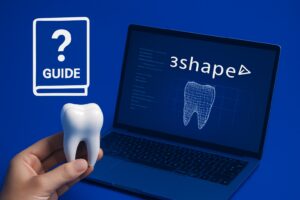Dental practice management is evolving fast, and in 2025, cloud-based solutions are transforming how clinics operate. This comprehensive guide dives deep into open dental cloud, giving dental professionals the insights they need to make smart choices.
You’ll discover what open dental cloud is, its core benefits, security and compliance features, setup steps, integration options, pricing, and the latest trends. As more practices embrace cloud solutions, understanding how to leverage open dental cloud for efficiency, compliance, and better patient care is crucial. Use this guide to confidently navigate your cloud adoption journey.
What Is Open Dental Cloud?
Cloud-based solutions are transforming the way dental practices operate in 2025. Open dental cloud is at the forefront, offering a modern approach to practice management that breaks free from the limitations of traditional desktop software.

Overview of Open Dental Cloud
Open dental cloud is a comprehensive, cloud-based dental practice management software designed to streamline every aspect of dental office operations. Unlike on-premises versions, which require local servers and ongoing IT maintenance, open dental cloud runs securely in the cloud. This shift means practices can access patient data, schedules, and financial information from any device, at any time, whether in the office or working remotely.
The evolution from desktop to cloud in the dental industry has been rapid. Practices with multiple locations now benefit from centralized access, allowing teams to collaborate in real time. Open dental cloud operates on a subscription model, eliminating upfront hardware costs and reducing the burden of IT support.
Open dental cloud’s open-source foundation encourages continual improvement and customization, making it a favorite for tech-savvy dental professionals. The software’s ongoing development ensures it remains adaptable to modern workflows and regulatory requirements. For those seeking a deeper understanding of its roots and evolution, the Open Dental Software Complete Guide offers valuable context.
Recent statistics show a growing adoption of cloud-based dental solutions, with more practices choosing open dental cloud for its flexibility and convenience.
Core Features and Modules
Open dental cloud offers a robust suite of features tailored to the needs of modern dental practices. Its core modules include:
- Patient scheduling for easy appointment management across multiple providers.
- Digital charting and treatment planning to support accurate, up-to-date clinical records.
- Billing and insurance management for streamlined claims and payments.
- Comprehensive reporting to track practice performance and patient outcomes.
- Secure patient record storage with quick, authorized access for the care team.
- Built-in communication tools for seamless staff and patient messaging.
- Customization options such as templates, forms, and automated workflows.
- Integration capabilities with imaging, payment, and patient engagement tools.
A real-world example: a busy clinic with high patient volume leverages open dental cloud’s scheduling module to reduce front-desk bottlenecks. Staff quickly coordinate appointments, update records, and communicate with patients, all within the same platform.
The 2025 version brings a redesigned user interface, making navigation easier and enhancing overall user experience. Practices enjoy intuitive dashboards, faster load times, and mobile-friendly design, empowering teams to provide better, more efficient care.
Key Benefits of Open Dental Cloud
Adopting open dental cloud in 2025 brings a host of advantages that transform daily workflows for dental professionals. Whether you run a solo practice or manage a multi-location group, understanding these benefits can help you make the most of your system investment.

Enhanced Accessibility and Flexibility
With open dental cloud, you gain 24/7 access to your practice data from any device, anywhere. This flexibility empowers dentists, hygienists, and administrators to collaborate in real time, whether they are in the office, at home, or even traveling.
Practices with multiple locations can centralize data, ensuring that every team member sees up-to-date charts and schedules instantly. Remote work and telehealth services are also supported, making it easier to adapt to changing patient needs and staffing requirements.
If you want to dive deeper into the broad advantages of cloud-based dental platforms, check out this Benefits of Cloud-Based Dental Software resource for further insights.
By choosing open dental cloud, you set your practice up for greater efficiency and connectivity.
Scalability and Growth Support
Open dental cloud is designed to grow with your business. Whether you need to add new providers, expand to new locations, or onboard more support staff, the process is straightforward and cost-effective.
There is no need to invest in expensive servers or complex IT infrastructure as your practice expands. Adding users or locations is as simple as updating your subscription, with no interruptions to your daily operations.
This scalability makes open dental cloud an excellent choice for practices of all sizes, from solo practitioners to dental service organizations looking for a flexible solution.
Cost Efficiency and Affordability
Moving to open dental cloud means switching from large, upfront software and hardware expenses to predictable monthly subscription fees. This model reduces the financial barrier to entry for new practices and eliminates the need for ongoing IT maintenance.
Here is a quick comparison:
| Cost Factor | On-Premises | Open Dental Cloud |
|---|---|---|
| Hardware | High | None |
| IT Maintenance | Ongoing | Minimal |
| Upgrades | Manual | Automatic |
| Initial Cost | High | Low |
Small practices, in particular, appreciate how open dental cloud keeps budgets manageable while still delivering robust features.
Security and Compliance Advantages
Security is a top priority for every dental practice. Open dental cloud employs built-in encryption, strict access controls, and automated backups to protect sensitive patient information.
With HIPAA-compliant protocols, your data is safeguarded against unauthorized access and potential threats. The platform also helps you meet the latest regulatory standards, reducing your compliance burden.
For example, in the event of hardware failure or theft, your patient records remain safe and accessible, thanks to the cloud’s secure infrastructure.
Seamless Updates and Support
One of the standout benefits of open dental cloud is the ease of staying current. Software updates, bug fixes, and security enhancements are delivered automatically, so your practice always runs on the latest version.
You do not need to schedule downtime or coordinate manual upgrades. Plus, vendor-provided technical support and training resources are just a call or click away.
Many users report improved reliability and system uptime after migrating to open dental cloud, boosting overall productivity.
Customization and Integration Potential
Open dental cloud offers flexible customization options to fit your unique workflows. You can tailor charting templates, automate reminders, and personalize reports for different roles within your team.
The platform’s API allows seamless integration with third-party tools, such as imaging systems or patient communication platforms. For instance, a practice might link open dental cloud with specialized patient messaging software to enhance engagement.
As new dental technologies emerge, open dental cloud supports easy adoption, helping your practice stay ahead of the curve.
Security, Compliance, and Data Protection in 2025
As dental practices increasingly rely on cloud-based platforms, security, compliance, and data protection become paramount. In 2025, open dental cloud stands out by delivering robust safeguards tailored to the unique requirements of dental professionals and their patients.

HIPAA and Regulatory Compliance
Every dental practice must comply with HIPAA and evolving privacy laws. Open dental cloud is built with these requirements at its core, ensuring patient data stays confidential and protected. The platform undergoes regular audits and certifications to confirm compliance with both federal and state regulations.
Open dental cloud’s compliance features include detailed access logs, audit trails, and customizable consent forms. These tools help practices demonstrate accountability and transparency during inspections. In 2025, regulatory updates are seamlessly integrated, so users always operate within the latest legal frameworks.
Data Encryption and Access Controls
Open dental cloud employs advanced encryption for all data, both in transit and at rest. This means patient records are shielded from interception or unauthorized access, whether shared between offices or stored in the cloud. Multi-factor authentication (MFA) and role-based permissions further secure sensitive information.
For example, only authorized team members can view or modify clinical notes, while financial staff access billing data. By centralizing permissions, open dental cloud minimizes the risk of accidental data exposure and supports granular control over every record.
Backup, Redundancy, and Disaster Recovery
Unexpected events—such as hardware failures, ransomware, or natural disasters—can threaten practice data. Open dental cloud automatically performs daily backups, with geo-redundant storage across multiple secure locations. This setup ensures that if one data center goes offline, operations continue without interruption.
Disaster recovery protocols are tested regularly. In one real-world scenario, a practice restored all patient files within hours after a cyber incident, thanks to open dental cloud’s robust backup and recovery features. This peace of mind is invaluable for busy clinics.
Vendor Security Practices and Transparency
Open dental cloud’s vendor team maintains a proactive approach to security. Regular vulnerability scans, prompt patching, and ongoing monitoring are standard. If a potential threat is detected, incident response protocols kick in immediately, with clear user notifications and guidance.
Transparency is central to open dental cloud’s philosophy. Practices have access to up-to-date privacy policies and detailed documentation on how data is managed. Users can always review security practices, building trust between clinics and their technology provider.
Risks and Mitigation Strategies
While open dental cloud delivers strong technical defenses, human error remains a leading cause of breaches. Practices can mitigate risks by training staff on secure login habits, phishing awareness, and proper use of permissions. A 2025 industry report found that over 70% of dental data incidents stem from user mistakes versus system flaws.
To explore how open dental cloud’s security compares with other leading platforms, visit the Practice Management Software Overview. By following best practices and leveraging the platform’s built-in protections, dental practices can confidently safeguard patient information and remain compliant.
Setting Up and Migrating to Open Dental Cloud: Step-by-Step
Migrating to open dental cloud can seem daunting, but a structured approach makes the transition smooth and efficient. With the right preparation, your practice can quickly unlock the advantages of cloud-based dental management.
Pre-Migration Preparation
Before switching to open dental cloud, assess your current workflows and technology. Review your practice’s needs, including patient volume, number of locations, and any unique software requirements.
Inventory your existing data, software, and hardware. Identify which systems need to be migrated and which can be retired. Plan your migration timeline to minimize disruptions to patient care and office operations.
Draft a checklist to ensure nothing is overlooked:
- Evaluate internet connectivity and speed at all practice sites.
- Determine which team members need cloud access.
- Communicate the migration plan and set realistic expectations.
Early planning ensures a seamless open dental cloud adoption and helps avoid costly surprises.
Data Migration Process
Migrating your data is a critical step when moving to open dental cloud. Begin by exporting patient records, appointment histories, billing information, and other essential data from your legacy system or on-premises Open Dental.
Next, cleanse and validate your data to eliminate duplicates and correct errors. This improves accuracy and ensures a clean start in the cloud. Import your data into open dental cloud with support from the vendor or your IT partner. For a deeper dive into migration best practices, consult the detailed Open Dental Cloud Migration Guide.
Test the imported data for completeness and accuracy before going live. Careful attention here will set the stage for a successful transition to open dental cloud.
Configuring the Cloud Environment
Once your data is in open dental cloud, configure your new cloud environment to match your practice’s workflows. Set up user accounts, roles, and permissions to control access for staff members.
Customize templates, forms, and charting layouts to support your clinical and administrative processes. Integrate third-party tools for imaging, billing, or patient communication to enhance efficiency.
Take advantage of open dental cloud’s flexibility to tailor the system to your unique needs. This step ensures your team is ready to hit the ground running.
Staff Training and Change Management
Successful adoption of open dental cloud hinges on thorough staff training and proactive change management. Begin onboarding by introducing staff to the new interface and workflows.
Offer hands-on training sessions, online tutorials, and access to support resources. Address common concerns, encourage feedback, and highlight the benefits of the new system.
Empowering your team builds confidence and smooths the transition to open dental cloud.
Go-Live and Post-Migration Support
As you go live with open dental cloud, test all system functions to ensure everything works as expected. Verify data integrity, check appointment scheduling, and confirm billing processes.
Monitor performance closely in the first days and weeks. Encourage staff to report any issues or questions promptly. Rely on vendor support channels for troubleshooting and ongoing guidance.
Continued support and monitoring help your practice realize the full benefits of open dental cloud.
Example Migration Timeline
A typical migration to open dental cloud can be broken down week by week for a single-location practice:
| Week | Tasks |
|---|---|
| 1 | Assessment, planning, team meetings |
| 2 | Data export, cleansing, and validation |
| 3 | Data import, system configuration |
| 4 | Staff training, workflow testing |
| 5 | Go-live, monitor, address feedback |
Lessons learned from real-world migrations include the value of clear communication, early testing, and involving staff at every step.
Integrations, Customizations, and Advanced Features
Modern dental practices demand software that adapts to their evolving needs. Open dental cloud stands out by offering a rich ecosystem of integrations, customization tools, and advanced features designed for future-ready clinics.
Third-Party Integrations
Open dental cloud is engineered for seamless third-party integrations. Practices can connect imaging systems, e-prescription platforms, payment processing services, and analytics tools. API access empowers developers to link custom solutions or bridge existing workflows.
Consider a clinic that integrates open dental cloud with patient communication tools to automate appointment reminders and streamline follow-ups. This not only reduces no-shows but also enhances patient engagement. For a deeper dive into these capabilities, explore the Patient Communication Tools Integration resource.
With integrations like these, open dental cloud enables multi-location practices to unify their operations and data, boosting efficiency across all sites.
Customization Options
Every dental office is unique, and open dental cloud recognizes this with extensive customization features. Teams can create:
- Custom charting templates tailored to specialty workflows
- Automated reminders and task assignments
- Personalized reporting dashboards and analytics views
User interface personalization lets each staff member set up their workspace for maximum productivity. Automated workflows can trigger billing, insurance claims, or patient communications based on specific actions, saving valuable time.
These customization options ensure open dental cloud adapts to both small clinics and large DSOs, supporting growth and operational excellence.
Advanced Features in 2025
The 2025 release of open dental cloud introduces several advanced capabilities. AI-powered analytics provide actionable insights on patient care trends, revenue cycles, and appointment patterns. Telehealth modules support virtual consultations, allowing providers to expand services and reach more patients.
Mobile app enhancements make it easier for dentists and hygienists to review schedules, patient histories, and treatment plans on the go. These advanced features position open dental cloud as a leader in digital transformation for dental practices.
Future-Proofing Your Practice
Staying ahead in dentistry means embracing innovation. Open dental cloud releases regular updates, ensuring access to the latest features and security enhancements. Practices can participate in beta programs to test new modules and offer feedback.
Being part of the open dental cloud user community keeps teams informed on emerging dental technologies, from AI diagnostics to advanced imaging. By leveraging these tools, practices remain competitive and prepared for whatever the future brings.
Open Dental Cloud Pricing, Plans, and ROI
Understanding the cost structure of open dental cloud is crucial for making a smart investment in your practice’s future. In 2025, cloud-based dental management solutions offer flexible plans and clear ROI, making them an attractive option for practices of all sizes.
Subscription Plans and Pricing Structure
Open dental cloud operates on a subscription model, providing several plans tailored to different practice needs. Whether you run a solo clinic or manage multiple locations, you’ll find scalable options that bundle essential features like secure storage, technical support, and software updates.
Here’s a simplified comparison of typical plan tiers:
| Plan Type | Ideal For | Included Features |
|---|---|---|
| Single Practice | Solo practices | Core modules, basic support |
| Multi-Location | Growing groups | Centralized access, advanced support |
| Enterprise | DSOs, large clinics | Custom integrations, priority support |
For the latest details on monthly fees, included services, and add-ons, check the Open Dental Cloud Pricing Details.
Cost-Benefit Analysis
Investing in open dental cloud brings both immediate and long-term savings. Subscription pricing eliminates hefty upfront hardware costs and reduces the need for in-house IT staff.
Key ROI drivers include:
- Streamlined workflows that boost team productivity
- Lowered risk of data loss or downtime
- Enhanced patient satisfaction through faster, more reliable service
For example, practices have reported administrative overhead reductions of up to 25% after switching to open dental cloud. Over time, operational savings often outweigh the monthly subscription expense.
Licensing, Upgrades, and Hidden Costs
Transparency is a hallmark of open dental cloud licensing. You’ll find clear contract terms, straightforward monthly charges, and no surprise renewal fees. Software upgrades and new feature releases are included in the subscription, so your system stays current without extra effort.
Be mindful of potential costs like storage overages or advanced support tiers, but most practices find the predictable billing structure easier to manage than traditional software. Open dental cloud helps you avoid the pitfalls of hidden fees often seen with legacy solutions.
Who Should Consider Open Dental Cloud?
Open dental cloud suits a wide range of practice profiles. Startups benefit from low capital investment and fast setup, while established clinics appreciate the scalability and seamless multi-location support. Growing practices and DSOs can add users or locations with minimal disruption.
If your team values flexibility, predictable expenses, and reliable support, open dental cloud may be the right fit for your future growth. Evaluate your unique needs to determine if this modern platform aligns with your operational goals.
Expert Reviews and Unbiased Insights from Smart Molars
Choosing the right dental practice management software is a big decision. That is why many dental professionals turn to Smart Molars for in-depth, unbiased reviews. Known for its comprehensive evaluation process, Smart Molars has become a go-to resource for practices seeking clarity on the best solutions, including open dental cloud.

Smart Molars stands out by offering transparent, expert-driven insights. Their team understands that switching to or optimizing open dental cloud is not just about features, but about real-world impact on efficiency, compliance, and patient care. With so many software options available in 2025, having a trusted review platform is more important than ever.
How Smart Molars Evaluates Open Dental Cloud
When assessing open dental cloud, Smart Molars applies a strict set of criteria to ensure a well-rounded review. The main areas of focus include:
- Usability: How intuitive is the interface for new and experienced users?
- Security: Does the platform meet advanced compliance and data protection standards?
- Feature Set: What modules and integrations are available in 2025?
- Value: Is the pricing model fair for the features provided?
- Support: Are resources and technical help reliable and accessible?
This structured approach helps practices compare open dental cloud to other platforms with confidence.
Summary of Expert Findings
Experts at Smart Molars praise open dental cloud for its robust accessibility, real-time collaboration, and adaptable subscription plans. Many reviewers highlight the improved user interface in the latest version, plus seamless integration with third-party tools. However, some note that initial data migration can require careful planning, especially for larger practices.
A recurring theme is the enhanced security and compliance features, which give peace of mind to practices prioritizing patient data protection. For a detailed look at current features and improvements, readers can explore the Dental Software Reviews Category for comprehensive side-by-side comparisons.
Real-World Feedback and Testimonials
Dental professionals share that open dental cloud has streamlined front desk operations and improved patient scheduling. One clinic manager notes, “We reduced administrative time by 30 percent after migrating to open dental cloud, and our staff adapted quickly thanks to intuitive training resources.” Such testimonials reinforce the platform’s practical value across diverse practice types.
Making the Most of Smart Molars’ Resources
To get the most from Smart Molars, users can access comparison tools, guides, and expert articles tailored to open dental cloud and its alternatives. The platform’s unbiased approach helps practices identify the strengths and weaknesses that matter most to them. Additional resources, such as migration checklists and feature breakdowns, are also available for those seeking a deeper dive.
Whether you are a solo practitioner or part of a growing dental group, leveraging Smart Molars’ expertise can simplify the process of evaluating and adopting open dental cloud. Their clear, actionable insights can help your practice stay agile and competitive in 2025.

